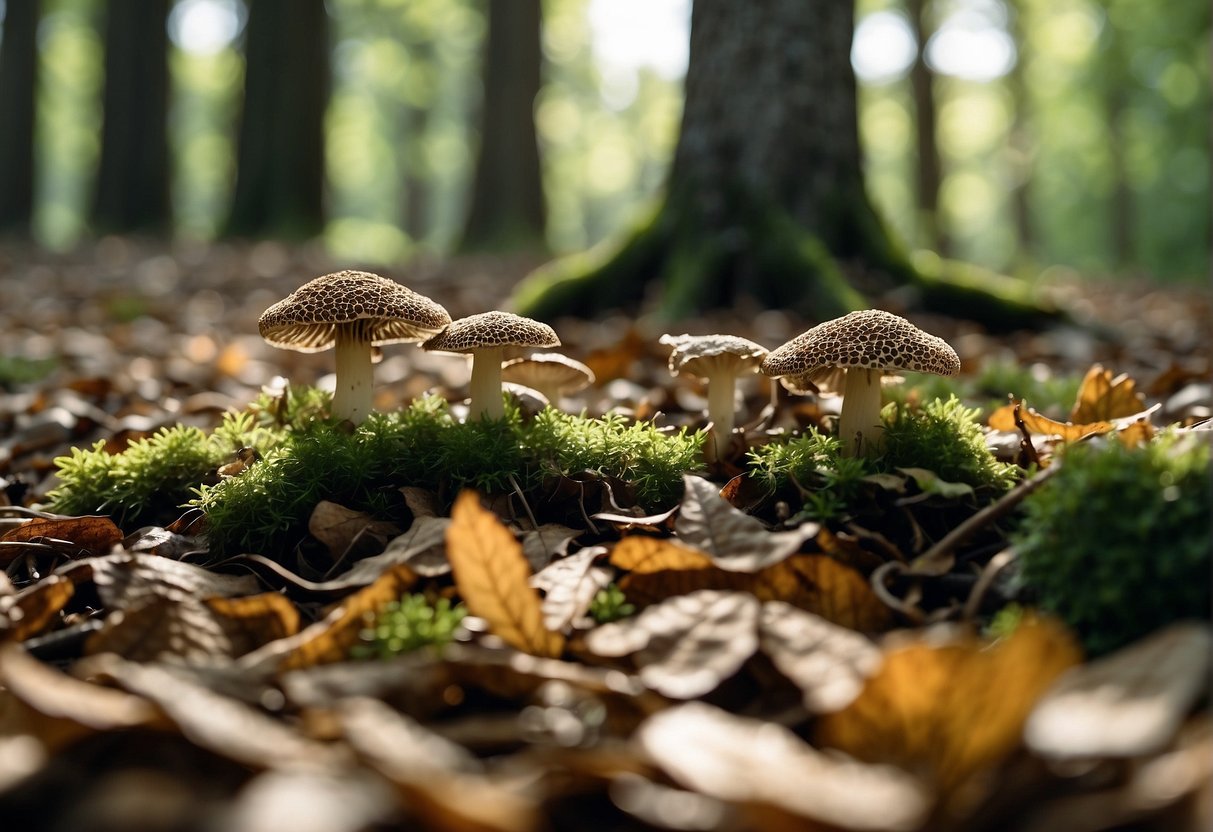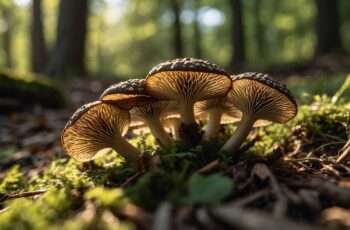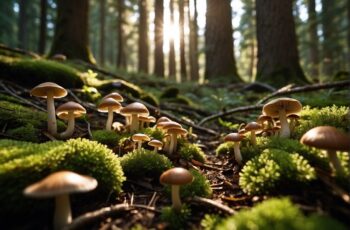Morel mushrooms are a true springtime treasure in Illinois, offering both an exciting outdoor activity and a culinary delight. As an enthusiast of the great outdoors, you’re likely familiar with the thrill of hunting for these elusive fungi. The Illinois landscape provides a hospitable environment for morels, and they can be found proliferating throughout the state during the spring months.

Whether you are new to morel hunting or a seasoned forager, you’ll find Illinois a prime spot for these distinctive mushrooms. They tend to grow in wooded areas, often flourishing in the moist soil near dying or dead trees. Your patience and keen eye can be greatly rewarded with a bountiful harvest of morels, which are not only a forager’s prize but also a gourmet’s delight.
Arming yourself with knowledge about the preferred habitats and conditions for morel growth can significantly increase your chances of success. Morels have a symbiotic relationship with certain tree species, making areas with elm, ash, aspen, and oak a good place to start your search. Remember that timing is everything as the morel season in Illinois is quite brief, so ready your mesh bag and let the hunt begin!
Identifying Morel Mushrooms in Illinois
When seeking out morels in Illinois, knowing their distinct features and varieties will help you distinguish genuine morels from their false counterparts.
Varieties of Morels
In Illinois, you’ll encounter primarily three varieties of morels: Yellow Morel, distinguished by its tan to yellow cap; Black Morel, which sports a darker, rich brown to almost black cap; and the Half-Free Morel, recognizable by the cap partially attached to the stem. These are the types you are most likely to find during your foraging adventures.
Identifying Characteristics
- Cap Shape: Look for a honeycomb pattern on the cap with ridges and pits.
- Color: True morels range from creamy yellow to dark gray or black.
- Stem: They have a white to pale cream stalk that is typically thicker compared to the cap.
- Smooth Interior: When sliced in half, a true morel will have a hollow stem and cap with no cottony or fibrous substances inside.
By observing these characteristics, you can feel confident in your ability to correctly identify morels in the wild.
False Morels Versus True Morels
Distinguishing true morels from false ones is crucial for your safety. False morels have a wrinkled or “brainy” look rather than the honeycomb pattern. Their caps are often irregular and the inside of the stem is not completely hollow, sometimes filled with cottony fibers. Be extremely cautious as false morels can contain harmful toxins. Here are quick comparison points:
- Cap Attachment: In true morels, the bottom of the cap is typically attached to the stalk. If the cap hangs freely like a skirt, it’s likely a half-free morel or a false morel.
- Cap Interior: Check that the cap is hollow. If you find it solid or with chambers, it’s a false morel and should be avoided.
- Overall Shape: A true morel will appear more uniformly conical, whereas false morels are often bulging or asymmetrical.
Feel confident in foraging as you familiarize yourself with these details, enhancing both your safety and success in the Illinois woodlands.
Best Practices for Morel Foraging
Venturing into the woods for morel hunting requires a balance of skill, respect for nature, and the right gear. Below, you’ll discover how to forage responsibly, what equipment to bring along, and essential safety guidelines to ensure your morel hunting is both successful and enjoyable.
Foraging Ethics
When you enter the woods in search of morels, it’s your responsibility to tread lightly. As a steward of nature, ensure you’re only picking ripe morels and leaving the young to mature. Familiarize yourself with local regulations and private property boundaries to avoid foraging in restricted areas. Always aim to leave the habitat as undisturbed as possible to permit future growth and ecological balance.
Equipment Checklist
For an efficient forage, your backpack should include:
- A knife for cleanly cutting the stems
- A mesh bag which allows spores to disperse, promoting new growth
- Brush to gently remove debris from your morels
Maps are invaluable, so consider both physical and digital copies to guide your hunt. Keep an eye on the weather, as morels are plentiful after rain, and mild temperatures are key.
| Essential Item | Purpose |
|---|---|
| Knife | Harvesting Morels |
| Mesh Bag | Carrying and Spore Dispersal |
| Brush | Cleaning Morels on-site |
| Maps | Navigating Hunting Areas |
Safety Tips
Your safety is paramount during any morel hunt:
- Check weather forecasts to dress appropriately and avoid getting caught in inclement weather.
- Let someone know where you’re going and when you expect to return.
- Stay hydrated, and be mindful of your surroundings to prevent getting lost or encountering wildlife.
Remember, if you’re unsure whether a mushroom is a morel, err on the side of caution and don’t eat it. Misidentification can lead to serious health risks.
Understanding Morel Habitats
When you’re on the hunt for morel mushrooms in Illinois, knowing their preferred habitats greatly increases your chances of success. Morels thrive in specific conditions that include a symbiotic relationship with certain trees and the right soil composition.
Tree Associations
Your quest for morels should begin in woodlands where certain trees enhance morel growth—apple trees, for instance, are notorious for their partnerships with these fungi. The forests of Illinois, rich in biodiversity, offer a variety of other trees under which morels flourish. Nature has created an intricate bond between morels and trees such as:
- Elm (especially dying or dead)
- Ash
- Poplar
- Oak
Tracing the roots of such trees will lead you toward fruitful morel spots, as these funguses favor the protective and nourishing environment provided by tree partnerships.
Soil and Terrain
Morels are particular about the soil they call home. Your search should focus on areas with neutral to alkaline soils, as the natural pH levels in these areas provide an environment where morels can prosper. Illinois’ terrain, often composed of such soil types, sets the stage for your foraging adventure. Look for these aspects of terrain:
- Limestone-rich areas
- Well-drained slopes
- Moist, but not waterlogged ground
Remember to assess the surroundings, as morels are less likely to be found in heavily disrupted or acidic soils. Your familiarity with Illinois’ natural terrain can make all the difference in locating these elusive mushrooms.
Morel Season in Illinois
As an enthusiast of the great outdoors in Illinois, you await the thrill of morel mushroom hunting with anticipation. Grasp the nuances of seasonal patterns and prime locations to ensure your efforts are as fruitful as the forests after a spring rain.
Weather and Seasonal Patterns
You should plan your morel hunt in accordance with Illinois’ spring season, typically from late March through May. Morels thrive when soil temperatures reach about 50 degrees Fahrenheit. Keep an eye on the weather forecast, as ideal conditions include a warm rain followed by sunny days. These weather patterns drive the heat necessary for morels to sprout.
Finding Prime Morel Locations
To find these elusive fungi, focus on natural areas known for morel growth, such as woodland edges, floodplains, or hilly areas. Trails near dying elm trees, ash, and apple orchards are especially promising. Remember, morels enjoy the dapple of sunlight, so look for spots where the forest canopy isn’t too thick. Visit places like Jordan Block Park, if you’re looking for a community of hunters, or check with local outdoors groups for recent sightings.
Patience and persistence are your allies when scouring Illinois’ natural treasures for morels. Be prepared to venture out soon after favorable conditions materialize. Happy hunting!


